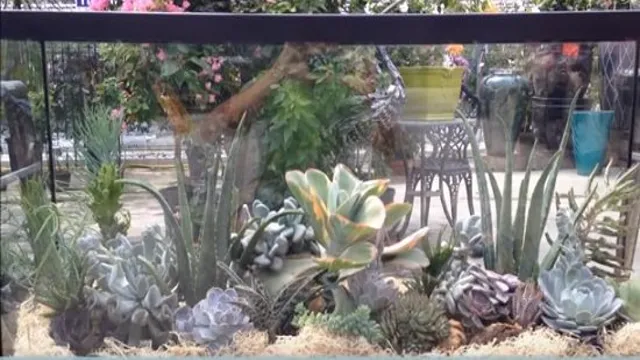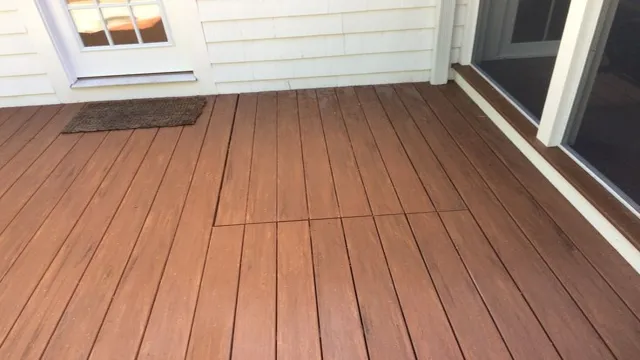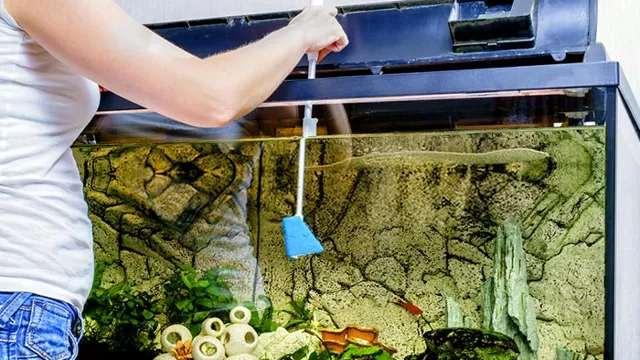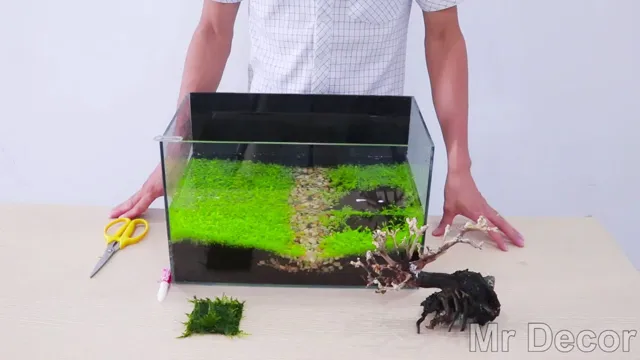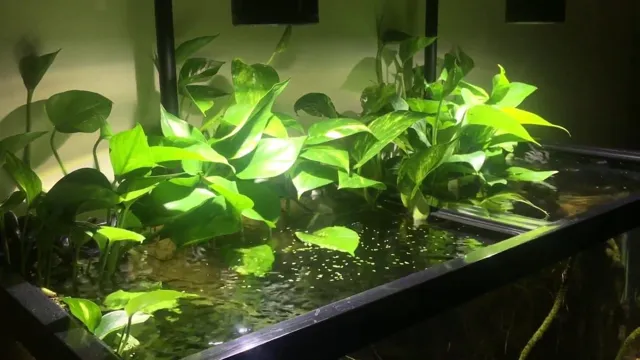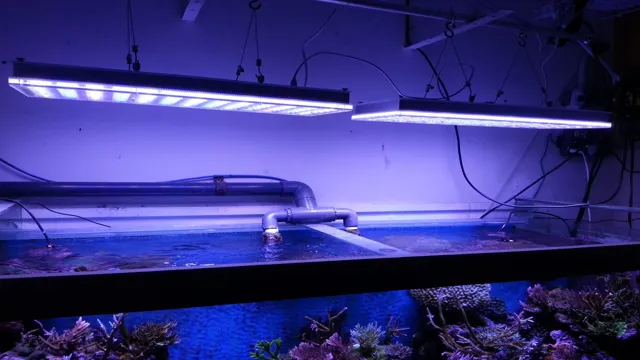For plant enthusiasts looking for a new way to display their favorite succulents, a succulent aquarium may be just the answer. These miniature underwater gardens are becoming increasingly popular among green thumbs who love to experiment with different ways to present their plants. A succulent aquarium is a lot like an aquatic terrarium, but it’s specifically designed to house plants that thrive in dry soil.
These aquariums are visually striking, with rocky landscapes and vibrant greenery that creates a stunning contrast against the water. But how do you make a succulent aquarium? Like any DIY project, it’s important to research materials and techniques beforehand to ensure success. With the right supplies, a bit of creativity, and some patience, you can have a beautiful aquatic garden of your own in no time.
In this post, we’ll talk about everything you need to know to create your own succulent aquarium. We’ll discuss the key materials required, including the right type of aquarium and substrate, and we’ll provide a step-by-step guide to assembling your miniature underwater landscape. Whether you’re a seasoned plant lover or just looking for a fun weekend project, a succulent aquarium is a creative way to showcase your favorite plants and add some natural beauty to your home.
So, let’s dive in and get started on creating your very own succulent aquarium!
Materials Needed
To make a succulent aquarium, you’ll need a few materials to get started. Firstly, you’ll need an appropriate aquarium tank. Depending on how many succulents you want to have, you can choose any size of the tank, but a standard 10-gallon tank will do just fine.
Next, you will need to purchase some aquarium gravel, which will serve as the base of the aquarium and provide drainage for the succulents. Additionally, you’ll need a layer of sand and a thin layer of activated charcoal, which will help to keep the water clean and reduce odors. Finally, you’ll need a variety of succulents- choose ones that are hardy and thrive in a slightly damp environment.
With these materials at hand, you’re well on your way to creating a beautiful and unique succulent aquarium that will add a touch of green to any room in your home.
Glass aquarium
Glass aquarium is an essential part of any fish keeper’s inventory. Whether you are a novice or an experienced hobbyist, having a well-built aquarium is crucial for the health and well-being of your fish. The main material needed to set up a glass aquarium is, of course, glass.
You will need a sturdy and durable glass to ensure the aquarium is leak-proof and can withstand the weight of water and substrate. Another important material is silicone sealant. You will need it to seal the joints after assembling the aquarium to prevent any leaks.
A proper stand is also crucial, and it must be able to support the weight of the aquarium and the water it holds. You will also need a filtering system, heating system, lighting, substrate, and decorations to make the aquarium habitable for your fish. Setting up a glass aquarium may seem complex, but with the right materials, your fish will comfortably thrive in their new home.

Potting soil
Potting soil is an essential component for any plant enthusiast looking to grow their greenery indoors. Before getting down to mixing this essential concoction, there are a few materials that one needs to have on hand. First and foremost, you will need a base soil mix, which can be obtained from your local garden supply store or, better yet, made at home from a combination of peat moss, vermiculite, and perlite.
The next critical ingredient to add is compost, which serves to enhance the soil’s nutritional value. Lastly, don’t forget to add some sand, which will help with drainage and ensure airflow around the roots. All these materials, when combined in the right proportion, will give you nutrient-rich soil that provides adequate drainage, aeration, and support for your plant’s root structure.
With these materials at your disposal, you’re one step closer to creating a thriving indoor garden!
Decorative rocks/pebbles
Decorative rocks and pebbles are a popular choice for adding a touch of natural beauty to your outdoor space. To create a stunning rock feature, you’ll need to gather a few essential materials. First and foremost, you’ll need to decide on the type of rock or pebble that you want to use.
Some popular options include river rock, granite, and lava rock. You’ll also need to think about the size of the rocks – larger rocks will create a bold statement, while smaller pebbles are better suited for filling in gaps. Other materials you’ll need include a base material, such as landscape fabric and sand, to prevent weeds from growing through your rock feature.
You might also want to consider using border edging to help contain your rocks in one area. With the right materials, you can create a beautiful and natural-looking rock or pebble feature that will add visual interest and personality to your outdoor space.
Activated charcoal
Activated charcoal is a popular natural ingredient used for a variety of purposes, including teeth whitening, skin care, and even emergency toxin removal. To create activated charcoal at home, you’ll need a few simple materials. First, you’ll need wood or coconut shells, which will be the base for your charcoal.
Next, you’ll need a metal container or drum to hold your materials while they are being heated. You’ll also need a heat source, such as a campfire or stove top. Finally, you’ll need a container of water to help cool and stabilize the charcoal after it’s been heated.
By following a few simple steps, you can create high-quality activated charcoal that’s free from harmful chemicals and additives. So why not give it a try? Not only is it fun and easy to make, but you’ll also have a natural and effective ingredient that you can use in a variety of ways.
Succulent plants
When it comes to creating a succulent garden, there are a few materials that you will need to get started. First and foremost, you will need some high-quality potting soil that is well-draining. Succulents don’t like to sit in wet soil, as this can cause root rot and other issues, so it’s essential to use a soil mixture that will allow excess water to drain away quickly.
You will also need a variety of succulent plants, of course! Try to choose plants that have different shapes, sizes, and colors to create an interesting and eye-catching display. Finally, you will need some containers to plant your succulents in. You can use anything from traditional terracotta pots to more unconventional options like seashells or teacups. (See Also: How to Kill Ciliates in Aquarium: Effective Strategies for Eliminating Harmful Parasites)
Just make sure that your containers have drainage holes to prevent water from building up and damaging the roots of your plants. With these key materials, you’ll be well on your way to creating a gorgeous and thriving succulent garden that you can enjoy for years to come.
Spray bottle
If you’re looking to make your own natural cleaning solutions or just need a convenient way to dispense liquids, a spray bottle is an excellent tool to have in your cleaning arsenal. To make a spray bottle, you’ll need a few materials including a clean and empty plastic bottle, a spray nozzle, and your choice of liquid. You can easily find these materials at a local hardware store or online.
When selecting your plastic bottle, make sure it’s large enough to hold the liquid you’ll be using and has a narrow mouth to fit the spray nozzle. The spray nozzle should have a compatible thread with the bottle and offer a fine mist setting. Once you have your materials, you can simply attach the nozzle to the bottle and fill it with your chosen liquid.
That’s it! Now you have a convenient and eco-friendly way to clean your home or garden.
Preparing the Aquarium
If you want to add a unique touch to your home décor, a succulent aquarium might be just the thing! Here’s how to make a succulent aquarium that’s sure to impress. First, you’ll need to choose an appropriately-sized aquarium and gather the necessary supplies: gravel for drainage, cactus or succulent soil mix, activated carbon for water filtration, and of course, succulents and cacti. Next, thoroughly clean your aquarium and add a layer of gravel to the bottom for drainage.
Then, add a layer of activated carbon to help filter the water. Once that’s done, it’s time to add your soil mix and carefully plant your succulents and cacti. Be sure to water them lightly after planting and let the aquarium sit for a day or so before adding water.
Once you’ve filled the aquarium with water, use a spray bottle to water the plants and keep the soil moist but not soaked. With a little attention and care, your succulent aquarium will thrive and make a beautiful addition to your home!
Clean and dry the aquarium
Preparing your aquarium is an essential part of owning fish. Before introducing any new fish to the tank, it is important to make sure that the aquarium is clean and dry. The first step in preparing your aquarium is to empty all the water from the tank and remove any decorations or plants.
Use a sponge or scraper to scrub the tank’s walls and remove any algae or debris left behind. Rinse the tank thoroughly with warm water to remove any remaining debris. Once the tank is clean, let it air dry completely.
Avoid using any cleaning agents or soaps as these can be harmful to fish. Preparing your aquarium in this way will ensure a healthy and safe environment for your fish to thrive in.
Add a layer of rocks/pebbles for drainage
Preparing your aquarium is a crucial step in ensuring the health and well-being of your aquatic pets. One important aspect of this process is adding a layer of rocks or pebbles for drainage. This layer serves as a barrier between the substrate and the water, allowing excess moisture to drain away and preventing anaerobic bacteria from building up.
Rocks or pebbles also provide stability to the substrate, creating a solid foundation for plants and decorations. When selecting rocks or pebbles for your aquarium, make sure to choose ones that are aquarium-safe and free from harmful chemicals or toxins. Additionally, be sure to rinse them thoroughly before adding them to your tank to remove any dirt or debris.
By taking the time to properly prepare your aquarium with a layer of rocks or pebbles, you can ensure that your aquatic pets thrive in a healthy and well-maintained environment.
Add a layer of activated charcoal for filtration
Before adding fish to your aquarium, it is important to properly prepare it. Adding a layer of activated charcoal can significantly improve the water filtration and overall health of your fish. Activated charcoal is known for its ability to absorb impurities and improve water clarity.
To add a layer of activated charcoal, first remove any decorations, rocks, or gravel from the tank. Then, rinse the activated charcoal thoroughly and spread it evenly across the bottom of the tank. Next, add a layer of sand or gravel on top of the charcoal to prevent it from being disturbed by the filter or air bubbles.
Finally, add water to the tank and let it run through the filtration system. Adding activated charcoal to your aquarium can help provide a clean and healthy environment for your fish to thrive in.
Add a layer of potting soil
Preparing your aquarium for your aquatic plants is crucial for their growth and longevity, and adding a layer of potting soil is an important step in the process. Potting soil provides essential nutrients that aquatic plants need to grow and thrive, and it also helps anchor them securely in the aquarium. When adding the potting soil, ensure that it is a suitable brand that is free from pesticides or any harmful chemicals that might harm your plants or aquatic pets.
A good option is a potting soil that is specifically formulated for aquarium plants. Carefully add a layer of the potting soil to the bottom of the aquarium before adding the gravel substrate on top. Be careful not to create clumps as these can lead to air pockets that can cause problems for your plants.
With a good layer of potting soil, your aquatic plants will not only look beautiful but also thrive in their new home.
Planting the Succulents
Now that you’ve gathered all your materials and have your aquarium ready, it’s time to start planting the succulents. First, fill the bottom of the aquarium with a layer of pebbles or small stones to aid in drainage. Then, add a layer of succulent soil. (See Also: How to Adjust pH in Aquariums: A Complete Guide for Beginners)
When planting your succulents, choose a variety of shapes and sizes to create an interesting and dynamic display. Start with the taller plants in the back and work your way forward. Be sure to leave enough space between each succulent to allow room for growth.
Once your plants are arranged to your liking, gently pack the soil around the roots. Finally, add a layer of decorative stones or sand to help retain moisture and give your aquarium a finished look. Remember to water your succulents sparingly, as they prefer a dry environment, and your succulent aquarium will thrive.
Choose a variety of succulent plants
When planting succulent plants, it’s essential to choose a variety of types to create different textures and colors in your garden or pot. You want to make sure that you have a mix of tall and short succulents, as well as different shapes and sizes. Some popular types to consider are echeverias, agaves, sedums, and aloe vera.
Once you’ve selected your succulents, you need to make sure you plant them in well-draining soil. Succulents don’t like their roots sitting in water, so a mix of cactus soil and perlite or sand is ideal. Make sure you choose the right size pot or container for the succulent, giving it plenty of room to grow.
It’s also important not to bury the succulent too deep into the soil, as this can cause root rot. Finally, water the succulent sparingly, allowing the soil to dry out completely between watering sessions. With these tips and proper care, your succulent plants will thrive and bring a beautiful pop of color and texture to your space.
Arrange the plants in the aquarium
When it comes to planting succulents in your aquarium, there are a few things to consider in order to ensure their success. Firstly, it’s important to arrange the plants in a design that looks appealing. One popular approach is to create a “succulent garden” by grouping various types of succulents together in one area.
This can create a natural and attractive look. Additionally, you’ll want to make sure each plant has enough space to grow and spread out. Avoid overcrowding the aquarium, as this can lead to stunted plant growth and poor water circulation.
Finally, remember to add the necessary nutrients and lighting to support your succulents. Plants like succulents typically require bright and indirect light, and benefit from regular fertilization. By taking these steps, you can create a thriving succulent aquarium that is both beautiful and healthy.
Spray the plants with water
When it comes to planting succulents, it’s important to ensure their environment is just right. One great way to do this is by spraying the plants with water. This helps to increase the humidity in the air and keep the plants healthy and hydrated.
When planting succulents, it’s important to choose a well-draining soil mix that allows excess water to run off easily. By doing this, you’ll avoid overwatering your plants, which can cause root rot and other health issues. Once you’ve planted your succulents, give them a good spray with water to help them settle in and acclimate to their new environment.
Be sure to check on them regularly and adjust your watering schedule accordingly. Remember – succulents are hardy plants, but they still need care and attention to thrive!
Add more potting soil around the plants
When planting succulents, it’s important to ensure they have enough room to grow. Start by choosing a pot that’s big enough to accommodate your plants, and then add a layer of potting soil to the bottom to provide drainage. Next, carefully remove your plants from their current containers, taking care not to damage their roots, and place them in the new pot.
Add more potting soil around the plants, gently pressing it down to secure them in place. Don’t worry if the soil level seems low at first; succulents don’t require a lot of soil to thrive. Finally, water the plants lightly and place them in a sunny spot.
Remember that succulents don’t like to be over-watered, so be sure to let the soil dry out between waterings. With the right care, your succulents will thrive and bring a touch of green to your home or garden.
Caring for Your Succulent Aquarium
Making a succulent aquarium can be a great addition to your home or office décor. When it comes to caring for your succulent aquarium, there are a few things to keep in mind. First and foremost, make sure you choose the right succulents for your aquarium.
You want to select plants that can thrive in a humid environment and won’t outgrow the tank quickly. Next, make sure your aquarium gets enough light. Succulents need bright, direct sunlight to grow, so consider placing your tank near a window or under a grow light.
Watering your succulent aquarium can be tricky – you want to make sure the plants get the right amount of moisture without causing water damage to the tank. It’s best to water your aquarium when the soil is dry and use a spray bottle to avoid over-watering. With proper care and attention, your succulent aquarium can thrive and bring a touch of natural beauty to your space.
Place the aquarium in a spot with bright, indirect light
If you’re considering creating a succulent aquarium, it’s essential to pay attention to the placement of your tank. Finding the perfect spot with bright, indirect light is crucial to maintaining your aquarium’s health and vibrancy. While direct sunlight can be harmful to your plants, they still need adequate light to thrive.
Placing your aquarium in a location where it can receive natural light, such as near a window or skylight, is ideal. However, it’s essential to avoid exposing it to direct sunlight, as this can cause your plants to burn or wilt. Keep in mind that some types of succulents, like cacti, require more direct light than others, so be sure to research your specific plant’s needs.
Finding the right balance of light for your succulent aquarium can help ensure that your plants stay healthy and beautiful for years to come. (See Also: How to Get Rid of White Mold in Aquarium: Tips and Tricks)
Water the plants only when the soil is completely dry
If you’re the proud owner of a succulent aquarium, congratulations! Caring for these unique plants can be a rewarding experience, but it’s important to make sure you’re giving them the proper care they need to thrive. One crucial tip is to water your plants only when the soil is completely dry. Succulents are equipped to handle periods of drought, so it’s important not to overwater them.
Overwatering can lead to rot and other issues that can harm your plants. Instead, let the soil completely dry out before watering again. This not only ensures that your plants are getting enough water, but also helps prevent any potential issues that could arise from overwatering.
So, keep a close eye on your soil and give your succulent aquarium the care it deserves!
Mist the plants with water occasionally
To keep your succulent aquarium thriving, it’s important to take a few simple steps. One of the easiest things you can do to care for your plants is to mist them with water occasionally. This will help keep the soil moist and provide your plants with the hydration they need to thrive.
You don’t want to overwater your succulents, though, as too much water can lead to root rot. Misting is a great way to keep your plants healthy without risking overwatering. Just be sure to use a spray bottle with a fine mist setting to avoid damaging your plants.
By taking a few simple steps to care for your succulent aquarium, you can enjoy their beauty and health for years to come.
Trim and prune the plants as needed
One important aspect of caring for your succulent aquarium is to periodically trim and prune the plants in it. This will help ensure that they continue to look healthy and vibrant, and prevent them from becoming too overcrowded. When trimming your succulents, be sure to use a sharp, clean pair of scissors or pruning shears, as jagged cuts can make your plants more susceptible to disease and damage.
As you trim, be sure to remove any dead or damaged leaves or stems, as well as any overcrowded growth. This will help ensure that your succulents have plenty of space to grow, and will prevent them from competing with each other for resources. With careful trimming and pruning, you can help your succulent aquarium thrive and become a beautiful and vibrant addition to your home or office.
Conclusion
In conclusion, creating a succulent aquarium is a perfect way to bring a little bit of the outdoors into your home. Not only are succulents easy to care for, but they also add a touch of liveliness and vibrancy to your space. By simply selecting a container, adding rocks and soil, and arranging your favorite succulents, you can create a unique and stunning aquarium that is sure to impress.
So why not make a splash and dive into the world of succulent aquariums today? Your plants (and your eyes) will thank you.”
FAQs
What materials do I need to make a succulent aquarium?
To make a succulent aquarium, you will need a glass container, aquarium gravel, potting soil, activated carbon, and various succulent plants.
How often do I need to water my succulent aquarium?
Succulent plants are known for their ability to store water in their leaves, which makes them low-maintenance. You should water your succulent aquarium every two to four weeks, depending on how dry the soil feels.
Can I use any type of container for a succulent aquarium?
Glass containers are the most popular choice for succulent aquariums, but you can also use a plastic container as long as it has a drainage hole.
What type of lighting do succulent plants need in their aquarium?
Succulent plants thrive in bright, indirect sunlight. You can place the aquarium near a window or provide artificial lighting that mimics natural sunlight.
How do I prevent root rot in my succulent aquarium?
To prevent root rot in your succulent aquarium, make sure that your soil is well-draining and that the container has a drainage hole. Avoid overwatering your plants and allow the soil to dry out completely between waterings.
Can I mix different types of succulent plants in one aquarium?
Yes, you can mix different types of succulent plants in one aquarium as long as they have similar water and light needs.
How do I prune my succulent plants in the aquarium?
To prune your succulent plants in the aquarium, use clean, sharp scissors to remove any dead or damaged leaves or stems. You can also trim the plants to control their size and shape.

